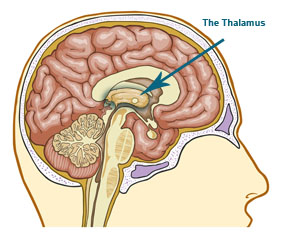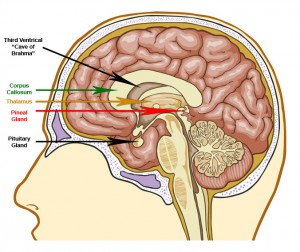Meditation and the Physical Transformation of the Brain: Part 1
One of the key structures in the brain that has been found to be physically changed through long-term meditation is the thalamus. Long-term meditation also affects the prefrontal cortex, the parietal lobe, and the middle prefrontal areas, but here I will focus on the changes to the thalamus and their implications.
 The thalamus is a walnut-shaped structure deep in the center of the brain. It is the relay station for all of the sensory information that flows throughout the brain. So, whether the information comes in through our optic nerves, our ears, through tactile sensation, through smell, or through taste, every bit of data travels through the thalamus. The thalamus mediates to us our sense of what is and isn’t real.
The thalamus is a walnut-shaped structure deep in the center of the brain. It is the relay station for all of the sensory information that flows throughout the brain. So, whether the information comes in through our optic nerves, our ears, through tactile sensation, through smell, or through taste, every bit of data travels through the thalamus. The thalamus mediates to us our sense of what is and isn’t real.
The physical correlates of all sensations, thoughts, and emotions first cascade through the thalamus before being communicated to the other parts of the brain. Even the smallest degree of damage to this crucial part of the brain can negatively affect other brain areas.
Very interestingly, the thalamus doesn’t make any distinction between what is inside of us and what is outside of us. It gives emotional meaning not only to what we take in through our senses, but also to our concepts of God and spirituality.
Just like the neocortex, or outer layer, of our brains, the thalamus has a right lobe and a left lobe. Activity in these two lobes is usually symmetrical in most people. What scientist Andrew Newberg has found in his studies is that the activity in these two thalamic lobes of long-term meditators is asymmetrical, meaning one of these lobes, either the right or the left, features more activity than the other. Moreover, this thalamic asymmetry is observed even when they’re not meditating. This is a major empirical observation in the sense that it qualifies as objective scientific evidence that long-term meditation is at least correlated with (if not the cause of) profound and lasting changes in the brain.
One of the interpretations that’s been given for this asymmetry is that through constant meditation we become aware of a deeper sense of being: we begin to experientially realize that we’re more than our minds, that we’re more than our brains, that there’s something deeper to our aspect that isn’t necessarily tied to our bodies or minds, and that it’s somehow connected to all things. The asymmetry in the thalamus seems to indicate that the more we become experientially aware of this larger sense of being, the more this awareness actually shifts our physiology.
Again, the thalamus mediates our everyday sensory experience of the world; but because we’re also experiencing this bigger spiritual reality deep within our interiors, this bigger sense of unity, this bigger and freeing sense of connection in deep meditation, every day over a period of months and years, what apparently happens is that one side of the thalamus becomes more active than the other. This implies that our interpretations of reality actually become part of our physiology—they actually transform our brains. Our habitual ways of interpreting reality will tend to more or less hardwire those interpretations into our brains.
As the thalamus begins to be transformed through deep meditation over a period of years, it may be essentially transmitting the tangible experience of this bigger reality, whether we call it God; or in Buddhism, Sunyata, emptiness; or in Hinduism, Shiva or Shakti; or spirit; or source; the larger reality becomes so real in our experience that it quite literally transforms the thalamus, resulting in a lasting asymmetry in the activity of the thalamic lobes.
In Newberg’s words, “. . . the more you focus on God, the more God will be sensed as real. But it will not be a ‘symmetrical’ reality. Instead, it will be perceived ‘asymmetrically,’ meaning that the reality will appear different from one’s normal perception.” Apparently, after many years of meditation practice, this asymmetric perception (i.e., God, spirit, source, sunyata, Shiva, Shakti, etc.) becomes an essential aspect of everday experience, just as real as anything else, possibly even more real; hence the asymmetrical activity.
In the yogic traditions, the central area in the brain which the thalamus occupies plays an important role in spiritual awakening. As the body’s immense nerve bundles emerge from the spine and into the brainstem, they travel first through the thalamus before being distributed through the corpus callosum as a great multitude of nerve fibers branching up throughout the neocortex, along the crown of the head. This multi-branching of millions of neurons in part comprises the physical correlate of the sahasrara or “crown” chakra, the subtle energy center also referred to as the thousand-petaled lotus in yogic philosophy.

In close proximity to this central area, where the bundle of nerve fibers meets in the thalamus, are the pituitary gland, the hypothalamus, the pineal gland, and the third ventrical, also known as the Cave of Brahma in Kriya Yoga. One or more of these central areas have been the inner focus of meditation in the various meditative traditions for thousands of years. This central area is often associated with profound insight, spiritual vision, and higher perception. As such, it has been referred to as the “third eye,” playing an equally central role in awakening the body’s bio-electrical system, including the latent kundalini-shakti in the root center as well as the consciousness of unconditional, heart-melting love in the heart center.
In view of the scientific research on how meditation affects the thalamus, then, we can see that the meditative traditions seem to have rightly placed emphasis on this central area as one of the important centers to focus on in meditation. According to the contemplative traditions, as the spiritual energy activated during meditation rises through the subtle energtic pathways of the human body and into this resonant central chamber, substantial and durable shifts in perception of self and world occur over time. And science seems to point to the notion that, in some measure, these transformations appear as an asymmetrical activity in the thalamus, bringing with it a palpable, lived experience of greater freedom and fullness.
Leave a Comment
You must be logged in to post a comment.

Leave your comments below